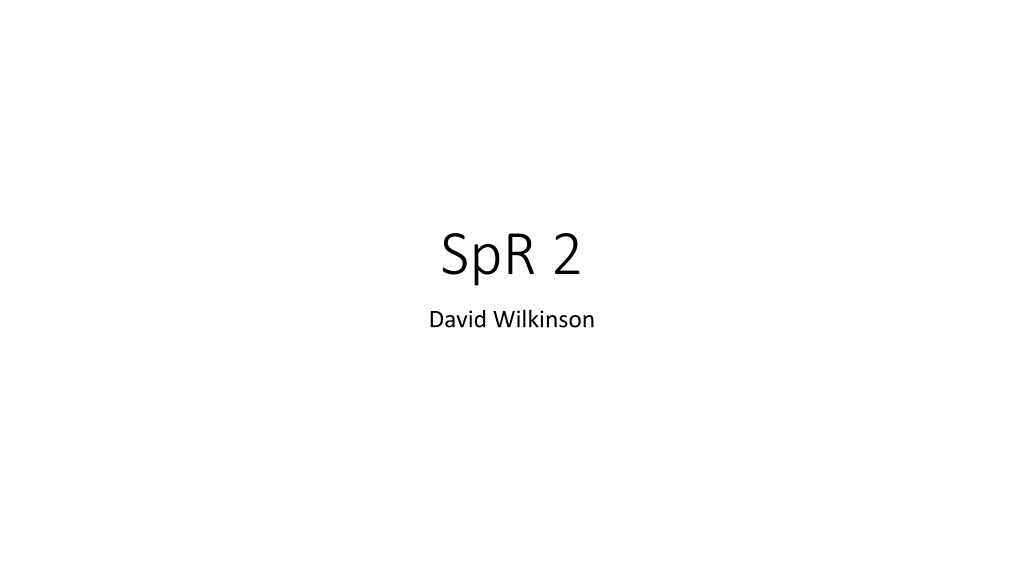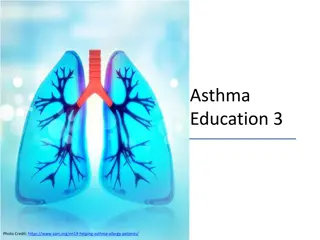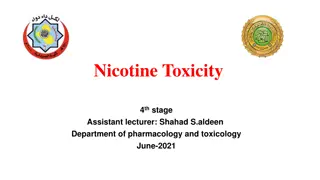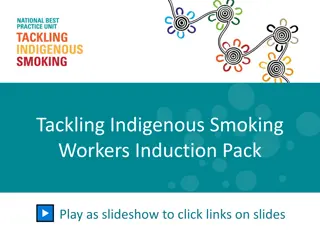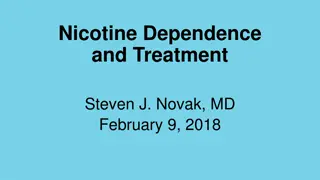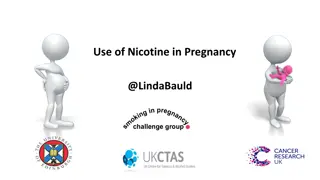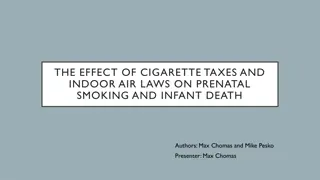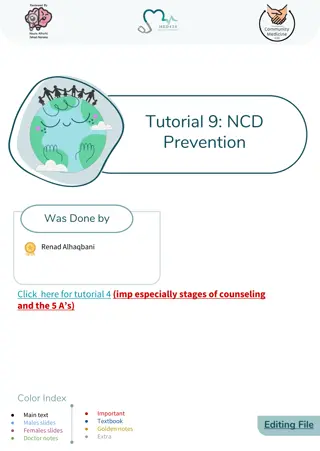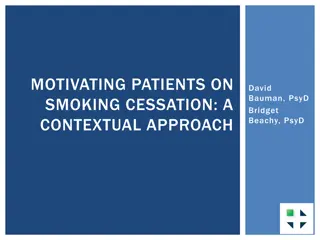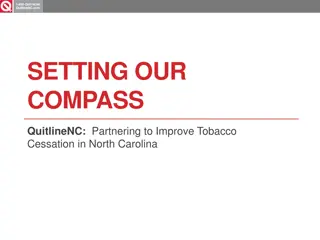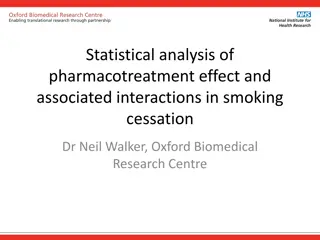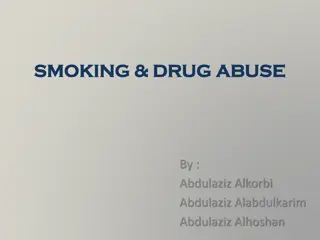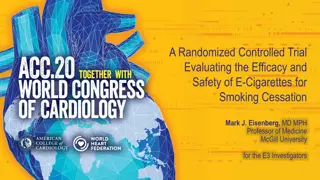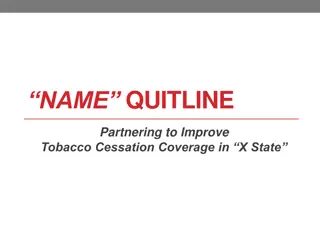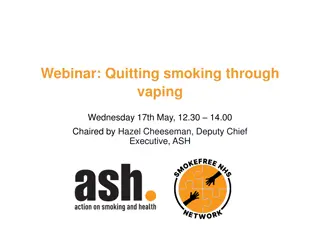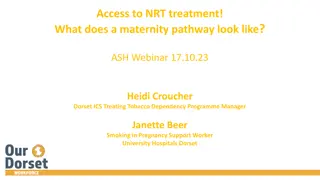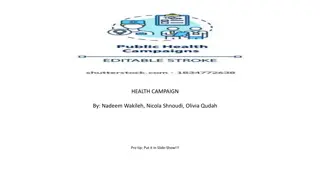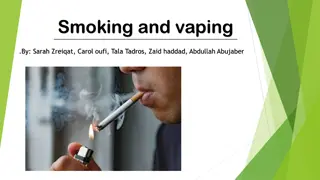Insights into Nicotine Effects and Smoking Cessation Medications
Nicotine acts as an agonist at nicotinic acetylcholine receptors in the brain, impacting dopamine release and opioid activity. It has a short half-life and is metabolized by the liver. Understanding its sedative effects at high doses and the development of tolerance and withdrawal symptoms is crucial. Varenicline and Bupropion are important medications for smoking cessation, each with unique mechanisms and considerations.
Download Presentation

Please find below an Image/Link to download the presentation.
The content on the website is provided AS IS for your information and personal use only. It may not be sold, licensed, or shared on other websites without obtaining consent from the author. Download presentation by click this link. If you encounter any issues during the download, it is possible that the publisher has removed the file from their server.
E N D
Presentation Transcript
SpR 2 David Wilkinson
Question 1 Which of the following is false? A Nicotine is an agonist at nicotine acetylcholine receptors in the Ventral Tegmental Area of the midbrain leading to increased dopamine release from the Nucleus Accumbens (mesolimbic pathway). B Nicotine also increases endogenous opioid release C Nicotine has a half life of 15 minutes D Nicotine is metabolised by the liver and is mainly excreted in urine. E Nicotine is a sedative at high doses
Question 1 Which of the following is false? A Nicotine is an agonist at nicotine acetylcholine receptors in the Ventral Tegmental Area of the midbrain leading to increased dopamine release from the Nucleus Accumbens (mesolimbic pathway). B Nicotine also increases endogenous opioid release C Nicotine has a half life of 15 minutes D Nicotine is metabolised by the liver and is mainly excreted in urine. E Nicotine is a sedative at high doses
Nicotine Half life of 1-2 hours Adrenaline and noradrenaline released from the adrenal medulla due to sympathetic innervation via the splanchnic nerves tachycardia and hypertension Tolerance develops via desensitize (Theory 1) or downregulate (Theory 2). Withdrawal irritability, restlessness, craving, anxiety, depression, insomnia Addiction is complex - combination of positive reinforcement and avoidance of withdrawal symptoms (complicated by tolerance) Nicotine being a sedative at high doses is known as Nesbitt s paradox
Question 2 Which of the following is true? A Varenicline or Bupropion should be started on the smokers Stop Date B Varenicline is a synthetic analogue of a naturally occurring nicotine acetylcholine receptor agonist C Bupropion is a nicotine acetylcholine receptor agonist and norepinephrine/dopamine reuptake inhibitor D Bupropion can be used in epileptics, but not Varenicline E Bupropion is also licensed in the UK as an atypical antidepressant
Question 2 Which of the following is true? A Varenicline or Bupropion should be started on the smokers Stop Date B Varenicline is a synthetic analogue of a naturally occurring nicotine acetylcholine receptor agonist C Bupropion is a nicotine acetylcholine receptor agonist and norepinephrine/dopamine reuptake inhibitor D Bupropion can be used in epileptics, but not Varenicline E Bupropion is also licensed in the UK as an atypical antidepressant
Varenicline (Champix / Chantix) Mode of action Synthetic analogue of a naturally occurring high affinity, partial 4 2 nicotinic acetylcholine receptor agonist derived from Cytisine (component of the seeds of the shrub Cytisus Laburnum Southern/Central Europe) Dosing Start 1-2 weeks before Stop Date + behaviour mod. 0.5 mg OD 3/7 0.5 mg BD 4/7 1mg BD 11/52 Course can be repeated Warnings Contraindicated: Pregnancy + breast feeding Caution: Epilepsy (lowers seizure threshold) / CKD (reduce dose) Side effects Nausea, headache, insomnia, vivid dreams Interest Smoked by WW2 German/Russian soldiers when tobacco was unavailable Tabex (Cytisine) was introduced in Bulgaria in 1964, but Varenicline was not introduced until 2006 Tabex never had studies that would meet European standards Tabex is a LOT cheaper, but recently failed to demonstrate non-inferiority to Varenicline
Bupropion (Zyban / Wellbrutin) Norepinephrine/dopamine reuptake inhibitor reduces cravings and antidepressant effect Nicotinic acetylcholine receptor antagonist reduces reward of cigarettes Mode of action Dosing Start 1-2 weeks before Stop Date + behaviour modification 150mg OD 150mg BD (total treatment 7-9 weeks) Warnings Contraindicated: Pregnancy + breast feeding Caution: Lowers seizure threshold (epileptics, acute alcohol/benzo withdrawal, eating disorders), severe cirrhosis Side effects Nausea, headache, anxiety. Interest Atypical antidepressant for major depression - unlike MAO/TCA/SNRI/SSRI) not associated with sexual dysfunction, weight gain, sleepiness Not licensed for as an antidepressant in the UK
Question 3 Which of the following is false? A Preferably pregnant women should stop smoking abruptly without any medication B Neither Varenicline nor Bupropion are licensed for use during pregnancy C Nicotine is probably a teratogen D Combination nicotine replacement is preferable to single product dosing (short acting or long acting alone) E Pregnant women should be referred to the local smoking cessation service for behavioural support
Question 3 Which of the following is false? A Preferably pregnant women should stop smoking abruptly without any medication B Neither Varenicline nor Bupropion are licensed for use during pregnancy C Nicotine is probably a teratogen D Combination nicotine replacement is preferable to single product dosing (short acting or long acting alone) E Pregnant women should be referred to the local smoking cessation service for behavioural support
Nicotine Replacement Therapy (NRT) When not pregnant: Prescribe Combination NRT more effective than single form i.e. Long acting NRT (patch) AND Short acting NRT (gum, lozenges, sublingual tablets, inhalator, nasal spray, oral spray). Patches are removed at night (16 hour patch), unless strong morning symptoms 24 hour patch 21mg/day 6-8/52 14mg/day 2/52 7mg/day 2/52 Stop Lower dose and shorter course if less than 10 cigarettes/day Slower titration is acceptable Should aim to NOT smoke on NRT (does not block nicotine unlike Varenicline/Bupropion) When pregnant (according to NICE): Nicotine is teratogenic (at least in animal embryo studies), but tar and carbon monoxide are more so Advised if possible to abruptly stop smoking with behavioural support alone Can use NRT but strongly advised to avoid concurrent smoking Short acting NRT is preferred to Long acting NRT although recognised less effective than combination!!! Varenicline and Bupropion are contraindicated in pregnancy and breast feeding
Question 4 Which of the following is true? A E-cigarettes can be prescribed by smoking cessation clinics B E-cigarettes are licensed as medications C Around 6% of adults in England currently use e-cigarettes D E-cigarettes are as successful as NRT in smoking cessation E Of current e-cigarette users, 45% are ex-smokers
Question 4 Which of the following is true? A E-cigarettes can be prescribed by smoking cessation clinics B E-cigarettes are licensed as medications C Around 6% of adults in England currently use e-cigarettes D E-cigarettes are as successful as NRT in smoking cessation E Of current e-cigarette users, 45% are ex-smokers
E-cigarettes (Vaping) Vaping prevalence around 6% in the UK Battery + Atomizer (vaporises via heating coil) + Tank No combustion = no smoke No tobacco Not licensed as medicines, but regulated by the Tobacco and Related Products Regulation 2016 Current vapers: 64.6% ex smokers, 30.5% smoke and vape, 4.9% never smoked 2019 UK multi-centre trial: 18.8% e-cigarette users are smoke free at 1 year vs. 9.9% using NRT Hajek P, Phillips-Waller A, Przulj D, Pesola F, Myers Smith K, Bisal N, Li J, Parrott S, Sasieni P, Dawkins L, Ross L, Goniewicz M, Wu Q, McRobbie HJ. A Randomized Trial of E-Cigarettes versus Nicotine-Replacement Therapy. N Engl J Med. 2019 Feb 14;380(7):629-637 Long term risks unclear, but there is associated respiratory pathology
Question 5 What was the most popular method for trying to quit smoking in 2020? A E-cigarettes / Vaping B Going Cold turkey (unassisted quitting) C Over the counter NRT D Prescribed NRT E Varenicline
Question 5 What was the most popular method for trying to quit smoking in 2020? A E-cigarettes / Vaping 27.2% B Going Cold turkey (unassisted quitting) Around 50% C Over the counter NRT 15.5% D Prescribed NRT 2.7% E Varenicline 4.4%
Question 6 How many manage to remain smoke free at one year when quitting unassisted (going cold turkey)? A 3-4% B 5-6% C 8-9% D 12-13% E 15-16%
Question 6 How many manage to remain smoke free at one year when quitting unassisted (going cold turkey)? A 3-4% B 5-6% C 8-9% D 12-13% E 15-16%
In England, 60% of smokers want to quit and 10% plan to in the next 3 months.
Three times more likely vs Cold Turkey or OTC NRT In England, 60% of smokers want to quit and 10% plan to in the next 3 months.
Question 7 Which of the following are the correct steps of Very Brief Advice (VBA)? A Ask, Advise, Act B Bring up, Berate, Behave C Enquire, Educate, Enforce D Raise, Review, Recommend E Seek, Support, Stop
Question 7 Which of the following are the correct steps of Very Brief Advice (VBA)? A Ask, Advise, Act B Bring up, Berate, Behave C Enquire, Educate, Enforce D Raise, Review, Recommend E Seek, Support, Stop
Very Brief Advice (VBA) NICE recommended (developed by National Centre for Smoking Cessation and Training) Designed to take less than 30 seconds Most smokers expect to be asked about their smoking Opinions change so VBA should be offered on a regular basis Evidence: Offer of smoking cessation aids = 68% more likely to stop smoking Offer of support = 217% more likely to stop smoking Ask Ask about tobacco use, their feelings, any previous attempts to quit/reduce use (?had help) Not about recording pack years. Remove the stigma and ask an open question. Advise How do you feel about your smoking? Advise them that medication + behavioural support gives the greatest chance of quitting Act Advise them on the benefits of quitting (improves O2 levels/smell/reduces risk of disease ) If motivated to stop Refer on to smoking cessation service If not motivated to stop Offer written info/contact information + discuss Harm reduction
5 As Contained in GOLD guidelines 1. Ask Tobacco use status for every patient at every clinic visit 2. Advise Strongly urge all tobacco users to quit 3. Assess Determine willingness and rationale of their desire to quit 4. Assist Aid the patient in quitting 5. Arrange Schedule follow up
Smoking cessation services Aims to treat 5% of smoking population a year Achieve 35% success at 4 weeks Success confirmed by CO monitoring of exhaled breath in the 4th week Carbon monoxide reading 10 ppm = non-smoker Provide: Behavioural support (individual and group) NRT Varenicline Bupropion Newcastle commissioned service
Behavioural support 12 week programme Weekly follow up Telephone support during lockdown Prescriptions from local pharmacy Discuss: Confirm readiness to quit Smoking cessation aids and side effects Withdrawal symptoms Ways to cope with cravings and avoid relapse High risk situations for relapse (e.g. drinking alcohol)
Question 8 In 2017 the government announced plans for a Smoke Free England by 2030. What percentage of the population still smoking do they class as Smoke Free England? A <8% B <5% C <3% D <1% E <0.3%
Question 8 In 2017 the government announced plans for a Smoke Free England by 2030. What percentage of the population still smoking do they class as Smoke Free England? A <8% B <5% C <3% D <1% E <0.3%
2011 2012 2013 2014 2015 2016 2017 2018 2019 19.8% 19.3% 18.4% 17.8% 16.9% 15.5% 14.9% 14.4% 13.9%
